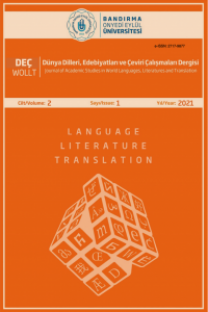Belgesel (Bilgilendirici) Çeviride Kalite Faktörleri
Çeviri modellerini ve kalite sistemlerini birleştirme zorluklarının bilinciyle, bu makalede söz konusu alanda yer alan ilgili gelişmelere genel bir bakış sunulmaktadır. Çevirinin pragmatik çağrışımlarını ve faaliyetini erek kullanıcıya odaklayan bir belgesel (bilgilendirici) çeviri yaklaşımı olan Kalite Paradigmasının metodolojik yönlerine özellikle vurgu yapılmaktadır.
Anahtar Kelimeler:
Kalite Sistemleri, Çeviri Modelleri, Pragmatik, Kalite Paradigması, Belgesel (Bilgilendirici) Çeviri
Quality Factors in Documentary Translation
Well aware of the difficulties involved in integrating translating models and quality systems, we offer an overview of relevant developments in the field. Particular emphasis is placed on the pragmatic connotations of translation and on the methodological aspects of the Quality Paradigm, an approach to documentary translation that focuses activity on the target user.
Keywords:
Quality Systems, Translating Models, Pragmatic, Quality Paradigm, Documentary Translation,
___
- Austin, N., Peters, T. (1986): Pasión por la excelencia. Méjico, Lasser Press, 1986.
- Balkan, L. (1992): Translation Tools. META, 37, 3, pp.408-420.
- Ballstaedt, S., H. Mandl (1984): Elaborations: assessment and analysis. In: Mandl, H., N. Stein, T. Trabasso (eds.), Learning and comprehension of text. London, Lawrence Erlbaum Associates.
- Bouthillier, F. (1993): Services d’information et evaluation du rendement du personnel. Argus, 22, 2, pp. 31-34.
- Brophy, P. (1995): Quality Management in Libraries. Proceedings of the 1st Northumbria International Conference. Performance measurement in Libraries and Information Services. Newcastle: University of Northumbria, pp. 77-81.
- Endres-Niggemeyer, B. (1989): Content analysis: a special case of text comprehension. In Proceedings: Information, Knowledge, Evolution. 44 FID Congress. Amsterdam, Elsevier.
- Flower, L., J.R. Hayes (1981): A cognitive process theory of writing. College Composition and Communication, 32, 365-387.
- Hjorland, B. (1992): The concept of “subject” in information science. Journal of Documentation, 48, 2, pp. 172-200. quality factors in documentary translation
- International Standard Organization (1977): Norm ISO 2384. Documentation. Presentation of Translation. Geneve, ISO.
- Krippendorff, K. (1990): Metodología de análisis de contenido. Teoría y practica. Barcelona: Paidos.
- Larose, R. (1994): Qualité et efficacité en traduction: réponse à F.W. Sixel. META, 39, 2, pp. 362- 373.
- Maillot, J. P. (1997): La traducción científica y técnica. Madrid, Gredos.
- Nord, C. ( 1996): El error en la traducción: categorías y evaluación. En: Hurtado, A. (ed.) La enseñanza de la traducción. Castellón, Universidad Jaume I.
- Ortega Y Gasset, J. (1958): Miseria y esplendor de la traducción. Obras Completas. Madrid, Revista de Occidente, 4ª edición, tomo V.
- Pinto, M. (1994): Interdisciplinary approaches to the concept and practice of written text documentary content analysis (WTDCA). Journal of Documentation, 50, 2, pp. 111-133. Award FID/MIP (Modern Information Professional) as the best article of the year.
- Rowley, J. ( 1996): Implementing TQM for library services: the issues. ASLIB Proceedings, 48, 1, pp. 17-21.
- Schaffner, C. (1998): From “Good” to “Functionally appropriate”: In: Schaffner, C. (ed), Translation and Quality. Clevedon, UK, Multilingual Matters, 1998.
- Schank, R.C. (1979): El papel de la memoria en el procesamiento del lenguaje, In COFER, Ch, (dir.) Estructura de la memoria humana. Barcelona, Omega.
- Theologitis, D. (1998): The Impact of New Technology on the Translator. Terminologie et Traduction, 1, pp. 342-351.
- Van Dijk, T.A., W. Kintsch, (1983): Strategies of discourse comprehension. New York, Academic Press.
- Williams, I.A.(1996): A translator’s reference needs: dictionaries or parallel texts? Target, 8, 2, pp. 275-299
- Yayın Aralığı: Yılda 2 Sayı
- Başlangıç: 2020
- Yayıncı: Bandırma Onyedi Eylül Üniversitesi
Sayıdaki Diğer Makaleler
Sabahattin Ali'nin "Birdenbire Sönen Kandilin Hikayesi"ndeki Gotik Unsurlar
XVI. Asır Aşk Mesnevilerinde Güzelin Tasviri
Hamdullah Hamdi'nin Yusuf U Züleyha Mesnevisi Bağlamında Züleyha'nın Femme Fatale Kişiliği
Hamdullah Hamdi'nin Yusuf U Züleyha Mesnevisi Bağlamında Züleyha'nın Femme Fatale Kişiliği
Belgesel (Bilgilendirici) Çeviride Kalite Faktörleri
Maria PİNTO, Çevirmen: Hanımnur MERCAN
L’enseignement Marocain Face Au Confinement: Enjeux et Solutions
Sabahattin Ali'nin "Birdenbire Sönen Kandilin Hikayesi"ndeki Gotik Unsurlar
